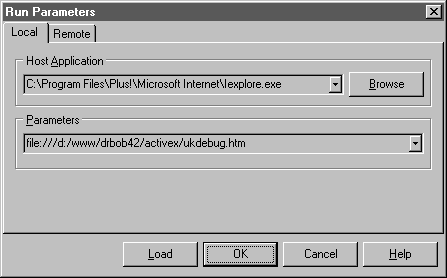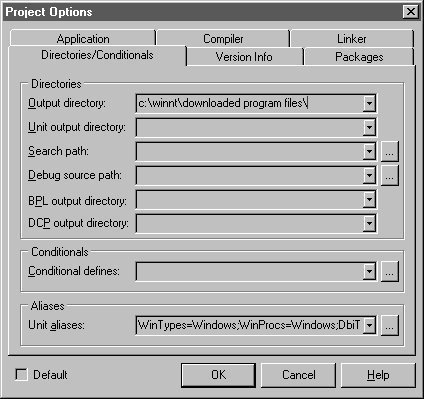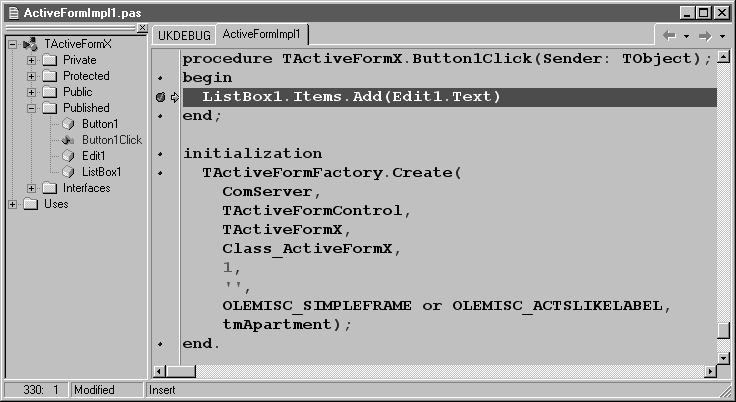| Delphi Clinic | C++Builder Gate | Training & Consultancy | Delphi Notes Weblog | Dr.Bob's Webshop |
| Delphi Clinic | C++Builder Gate | Training & Consultancy | Delphi Notes Weblog | Dr.Bob's Webshop |
| |||||
In this short article, first published in UK-BUG News, I'll show a few tricks that will help us debug ActiveForms from within the Delphi (or C++Builder) IDE itself.
We start with a simple ActiveForm. Just perform a File | New, and from the ActiveX tab pick the ActiveForm. Give it a name (like the default ActiveFormX). In our case, I also chose to specify UKDEBUG as project name, resulting in UKDEBUG.ocx as ActiveForm control. Since the goal of this article is (only) to show how to debug ActiveForm, I decided to give it a simple user-interface: a editbox, a button and a listbox. If you click on the button, then the Edit.Text is added to the Listbox.Items using the following line of code for the Button.OnClick event handler:
procedure TActiveFormX.Button1Click(Sender: TObject);
begin
ListBox1.Items.Add(Edit1.Text)
end;
Warning: this will be the only line of Delphi code that you need to write for this article!

The Project | Deployment Options dialog is filled-in as follows on my machine:

If you want to make sure that Internet Explorer automatically updates the local version of the ActiveForm with a new(er) edition of the ActiveForm (on the server), you must make sure to check the "Auto increment release number" option in the above dialog as well.
In a normal Delphi application, we could just set a breakpoint to the above code line, run the applciation from the IDE, and the breakpoint would trigger if we click on the button.
Unfortuately, this doesn't work quite like that for DLLs and OCXs (which is just a DLL with another extension).
Fortunately, we can use a "hosting" application to debug DLLs, as you all probably know.
And in the case of an ActiveForm, the hosting application is of course...
Internet Explorer (version 3 or higher).
So, just go to the Run | Parameters dialog, and "Browse" to the location of Internet Explorer (in the C:\Program Files\Plus!\Microsoft Internet\ directory in my case).
Also, since I deployed the ActiveForm to the d:\www\drbob42\ActiveX\ directory on my local machine, and the resulting HTM file will be named UKDEBUG.htm (remember the project name we specified in the beginning), I can already specify a "start-up" argument (or parameter) for Internet Explorer that will start it with the page that shows the ActiveForm itself.

This will almost work, but not quite, since Delphi will only "trigger" the breakpoint if Internet Explorer loads the version of the ActiveForm that Delphi created as output (i.e.
the UKDEBUG.ocx file in the project directory).
And Internet Explorer will not load that particular copy of our ActiveForm, but rather it will pick up the deployed version from the d:\www\drbob42\ActiveX\ directory and copy if to either the OCCACHE directory or the "Downloaded Program Files" directory (both subdirectories of the WINNT directory in my case) and load the OCX from that particular directory.
So, in order for Delphi to know that Internet Explorer is loading the Delphi-version of the ActiveForm, we must simply set the Output Directory to that location already using the Project | Options dailog.

This will make sure that after each rebuild or recompile the ActiveForm will be placed in the c:\winnt\Downloaded Program Files\ directory. During the "Deployment", the ActiveForm will be copied to the d:\www\drbob42\ActiveX\ directory. When we run the application, Internet Explorer will pick up the file from the d:\www\drbob42\ActiveX\ directory, copy it to the c:\winnt\Downloaded Program Files\ directory (overwriting the one we just created when we compiled - but with the same version), and load the ActiveForm from that directory. When the breakpoint is triggered, Delphi will know that the ActiveForm (currently being debugged) is indeed the one loaded by Internet Explorer, so it will nicely break inside the IDE for us:

Quite handy and helpful in times when you really need to debug your ActiveForm (and can't afford to put the code back into a "plain" Form). This also works when debugging N-Tier applications, which is a topic for next time...